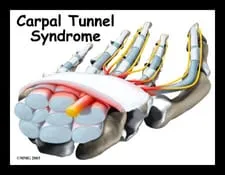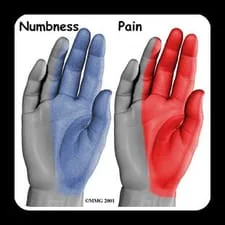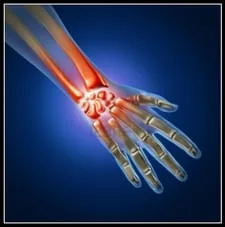What is Carpal Tunnel Syndrome?
Carpal tunnel syndrome occurs when the Median nerve, which runs from the forearm into the palm of the hand, becomes compressed

Symptoms
Symptoms usually start gradually, with frequent burning, tingling, or itching numbness in the palm of the hand and the fingers, especially the thumb and the index and middle fingers. Some carpal tunnel sufferers say their

Causes
Carpal tunnel syndrome is often the result of a combination of factors that increase pressure on the median nerve and tendons in the carpal tunnel, rather than a problem with the nerve itself. Most likely the disorder is due to a congenital predisposition - the carpal tunnel is simply smaller in some people than in others. Other contributing factors include trauma or injury to the wrist that cause swelling, such as sprain or fracture; overactivity of the pituitary gland; hypothyroidism; rheumatoid arthritis; mechanical problems in the wrist joint; work stress; repeated use of vibrating hand tools; fluid retention during pregnancy or menopause; or the development of a cyst or tumor in the canal. Carpal tunnel syndrome is also associated with pregnancy and diseases such as diabetes, thyroid disease, or rheumatoid arthritis. In some cases no cause can be identified.
Repetitive and forceful movements of the hand and wrist during work , sports, or daily activities can cause carpal tunnel syndrome. Repeated motions performed in the course of normal work or other daily activities can result in repetitive motion disorders such as bursitis and tendonitis. Writer's cramp - a condition in which a lack of fine motor skill coordination and ache and pressure in the fingers, wrist, or forearm is brought on by repetitive activity - is not a symptom of carpal tunnel syndrome.
Risk Factors
Women are 3 times more likely than men to develop carpal tunnel syndrome, perhaps because the carpal tunnel itself may be smaller in

The risk of developing carpal tunnel syndrome is not confined to people in a certain profession,but is especially common in those performing assembly line work - manufacturing, sewing, finishing, cleaning, meat, poultry, or fish packing. Carpal tunnel syndrome is 3 times more likely among assemblers than data-entry personnel. A 2001 study by the Mayo Clinic found heavy computer use (up to 7 hours per day) did not increase risk of developing carpal tunnel syndrome. In 1998, an estimated 3 of every 10,000 workers lost time from work because of carpal tunnel syndrome. Half of these workers missed more than 10 days of work. The average lifetime cost of carpal tunnel syndrome, including medical bills and lost time from work, is estimated to be about $30,000 for each injured worker.
Diagnosis
Early diagnosis and treatment are important to avoid permanent damage to the median nerve. A physical examination of the hands, arms, shoulders, and neck can help determine if the patient's complaints are related to daily activities or to an underlying disorder, and can rule out other painful conditions that mimic carpal tunnel syndrome. The wrist is examined for tenderness, swelling, warmth, and discoloration. Each finger should be tested for sensation, and the muscles at the base of the hand should be examined for strength and signs of atrophy. Routine laboratory tests and X-rays can reveal diabetes, arthritis, and fractures.
CHIROPRACTORS can use specific tests to re-produce the symptoms of carpal tunnel syndrome. The Tinel test, the CHIROPRACTOR taps on or presses on the median nerve in the patient's wrist. The test is positive when tingling in the fingers or a resultant shock-like sensation occurs. The Phalen, or wrist-flexion, test involves having the patient hold his or her forearms upright by pointing the fingers down and pressing the backs of the hands together. The presence of carpal tunnel syndrome is suggested if one or more symptoms, such as tingling or increasing numbness, is felt in the fingers within 1 minute. Chiropractors may also ask patients to try to make a movement that brings on symptoms.
Sometimes it is necessary to confirm the diagnosis by use of electrodiagnostic tests. In a nerve conduction study, electrodes are placed on the hand and wrist. Small electric shocks are applied and the speed with which nerves transmit impulses is measured. In electromyography, a fine needle is inserted into a muscle; electrical activity viewed on a screen can determine the severity of damage to the median nerve. Ultrasound imaging can show impaired movement of the median nerve. Magnetic resonance imaging (MRI) can show the anatomy of the wrist but to date has not been especially useful in diagnosing carpal tunnel syndrome.
Treatment
Treatments for carpal tunnel syndrome should start as early as possible, under a Chiropractor's direction. Underlying causes such as
